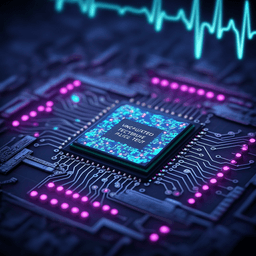
Engineering and Technology
A touchless user interface based on a near-infrared-sensitive transparent optical imager
T. Kamijo, A. J. J. M. V. Breemen, et al.
Discover the innovative touchless user interface developed by Takeshi Kamijo and team using a visually transparent near-infrared photodetector array. This groundbreaking research pushes the boundaries of NIR camera-based technologies, reducing calibration needs and enhancing user interaction through gesture control.
~3 min • Beginner • English
Introduction
Touch screens dominate human–machine interaction, yet there is growing demand for hygienic touchless interfaces for ATMs, kiosks and public terminals. Existing systems often use NIR cameras but suffer from limited field of view and require calibration. The authors aim to develop a visually transparent, NIR-sensitive organic photodetector (OPD) imager that can be placed directly in front of a display to enable accurate, calibration-free touchless interaction by detecting NIR light reflected from fingers/hands. They propose a 16 × 16 OPD array with patterned subpixels and a printed copper grid transparent electrode, optimized via electro‑optical modelling for high NIR sensitivity and high visible transmittance.
Literature Review
The paper reviews alternative touchless interaction technologies, including voice recognition, eye tracking, near-field communication, RF-based gesture sensing and optical gesture/motion detection. Commercial systems like Microsoft Kinect (time-of-flight, metre-scale range requiring calibration) and Leap Motion Controller (sub-millimetre accuracy but limited interaction volume of ~60 × 60 × 60 cm^3) are discussed. ShadowSense touch infers position from shadows cast across multiple sources/sensors. NIR at ~850 nm is commonly used due to high skin reflectance (up to ~70%) and invisibility. Prior studies on metal grid electrodes for OPVs/OPDs show performance trade-offs and typical use of wider grid lines than this work; modelling and experiments have optimized grids, but not at the sub-3‑µm widths implemented here.
Methodology
Device design and materials: An inverted OPD stack comprises a printed Cu grid transparent conductive electrode (70–120 nm thick; line width 1 µm, pitch 20 µm, ~100 nm thickness), a sputtered a‑IGZO (16 nm) electron transport/hole blocking layer, an SU8 edge cover layer (~1.8 µm), and a 300 nm bulk-heterojunction active layer of PCE‑10 (PTB7‑Th) donor and IEICO‑4F acceptor (2:3 wt) slot‑die coated and photolithographically patterned into subpixels. A 60 nm MoO3 hole transport layer and ~100 nm ITO top electrode are deposited, followed by an optically transparent laminated barrier film (160 µm) for encapsulation. The patterned OPD forms an array of parallel 50 × 50 µm^2 subpixels with pitch 240 µm and 5–10 µm overlap to SU8.
Electro‑optical simulations: EQE was optimized via coupled optical (transfer matrix method) and electrical (drift–diffusion) simulations in Setfos 5.2 for stacks on Cu lines and in gaps, combined with 2D FEM (Laoss 4.0) modelling of current distribution across the Cu grid to derive global EQE. Grid geometries (1–2 µm widths; 2–80 µm pitches) were explored; simulations matched experiments within ~1% and yielded design rules favoring 1 µm width with 10–20 µm pitch.
Optical transmittance model: The patterned OPD array’s VLT was predicted by combining simulated transmittance of three components—photoactive areas, open areas, and Cu lines—weighted by their fill factors. ISO 9050 was used to compute VLT. Designs targeting subpixel pitch 240 µm and Cu pitch 20 µm maximize VLT (~70%) while preserving sufficient active area.
Device fabrication and characterization: Discrete OPDs using a 9 × 9 subpixel array (total active area 0.2025 mm^2 within a 4 mm^2 main pixel) and arrays (16 × 16 main pixels; each main pixel with 14 × 14 subpixels, total active area 0.49 mm^2) were fabricated. The array pixel pitch is 6.24 mm (sensor area ~9.7 × 9.7 cm^2). Electrical characterization included J–V in dark and under 850 nm illumination, linearity vs intensity (200 nW cm^-2 to 0.8 mW cm^-2), EQE spectra, responsivity, noise spectral density (0.1–100 Hz) using a TIA and dynamic signal analyzer, and transient response to 50 ms and 1 ms 850 nm pulses.
Array readout: A readout IC (Analog Devices AD71124) collects pixel currents at −2 V bias via a custom FPGA/USB system. For operation in ambient light, bandpass filtering around modulation frequencies is used to reject static background.
Penlight demo: A custom battery-driven 850 nm LED penlight emits modulated signals at 800 Hz (right click), 960 Hz (left click), and 1200 Hz (idle). The system bandpass-filters pixel signals; x and y are computed by summing per column/row and Gaussian center-of-mass fitting. Zoom is controlled by moving the penlight toward/away during right-click.
Gesture demo: An array of 40 NIR LEDs (850 nm, total 0.35 W) around the imager illuminates a finger; reflected NIR is captured and processed similarly. A 1 kHz modulation enables narrow bandpass filtering. Position accuracy and SNR are evaluated from bandpass‑filtered pixel data.
Key Findings
- Optimized grid and OPD design: Simulations and experiments indicate an optimal Cu grid of 1 µm line width with 10–20 µm pitch. Patterned subpixels (50 × 50 µm^2, 240 µm pitch) maximize VLT while maintaining signal.
- Transparency: Patterned OPD array VLT ~64–70% (measured and modelled). With Cu pitch 20 µm and subpixel pitch 240 µm, VLT plateaus at ~70%, suitable for on‑display use.
- Discrete OPD performance: At −2 V, dark current density J_dark = 1.8 × 10^−10 mA cm^−2. Under 850 nm, 0.28 mW cm^−2, J_photo = 8 × 10^−2 mA cm^−2 (>10^4× J_dark). Linearity exponent a ≈ 0.93 over 200 nW cm^−2 to 0.8 mW cm^−2. EQE = 36% at 850 nm and 25% at 940 nm; SR = 0.25 A W^−1 (850 nm) and 0.19 A W^−1 (940 nm). Noise floor ~10 fA Hz^−1/2 above 10 Hz; noise-based D* = 1.1 × 10^12 Jones at 850 nm; dark-current-based D* = 7.2 × 10^12 Jones (noted to overestimate). Devices retain dark current over 6 months storage.
- Array characterization: Pixel photoresponse linear to 90 µW cm^−2 (R^2 = 0.99); beyond, saturation due to readout limits. Dark and light pixel currents show narrow Gaussian distributions: dark 3.7 ± 2.2 × 10^−6 mA cm^−2; light 1.5 ± 0.3 × 10^−2 mA cm^−2 at ~45 µW cm^−2. Transient response rise/fall times 2.4/2.8 ms (50 ms pulses). At 1 kHz modulation, array response is 37% of max (≈8.6 dB loss), yet mean SNR remains high.
- Penlight demo: With 1 kHz operation, mean SNR ≈ 54 dB across 256 pixels, enabling position accuracy ~20 µm (<0.25 pixel on a 160 ppi display). Panning and zooming (in/out) are demonstrated via frequency-coded clicks and distance modulation.
- Gesture demo: With perimeter LEDs (1 kHz), SNR ≈ 56 dB and finger position accuracy ≈0.65 mm (~4 pixels on 160 ppi display). Click gesture detected via intensity change with distance.
- Scalability and integration: The transparent imager operates in front of a display, mitigating field-of-view and calibration issues inherent to camera-based systems.
Discussion
Placing a transparent, NIR-sensitive OPD array directly on a display enables local detection of reflected NIR from fingers/hands, eliminating external camera field-of-view limitations and calibration. Electro‑optical modelling guides a design that balances high NIR sensitivity (36% EQE at 850 nm), low dark current and high detectivity with high visible transparency (~70%), preserving display visibility. Linear photoresponse facilitates both in-plane positioning and depth-based gestures. Demonstrations with a frequency‑coded penlight and with integrated NIR illumination validate robust operation in ambient environments through narrow bandpass filtering, yielding high SNR and sub‑pixel positional accuracy for penlight control and adequate accuracy for finger gestures. The use of printed sub‑micrometre Cu grids and photolithographically patterned OPD subpixels shows compatibility with scalable, display‑industry processes, suggesting practical adoption for hygienic touchless interfaces across diverse display sizes.
Conclusion
A large-area, visually transparent NIR-sensitive OPD array fabricated with a printed 1 µm Cu grid TCE and a patterned parallel subpixel architecture achieves high VLT (~70%), strong NIR sensitivity (EQE 36% at 850 nm), low dark current (~10^−10 mA cm^−2 at −2 V) and high detectivity (~10^12 Jones at 850 nm). A 16 × 16 sensor integrated in front of commercial displays enables touchless control using an NIR penlight and finger gestures without external cameras or calibration. The approach leverages scalable, flat‑panel compatible processes, indicating applicability to ATMs, signage and large interactive surfaces. Future work could focus on higher-resolution arrays, faster readout to avoid saturation at higher irradiance, improved high‑frequency response, and advanced algorithms/illumination for full hand tracking and richer gesture vocabularies.
Limitations
- Image sensor linearity saturates above ~90 µW cm^−2 at −2 V due to readout speed and pixel charge storage limits; higher bias or different readout settings are needed to extend range.
- At 1 kHz modulation, the transient response yields only ~37% of the maximum static signal (≈8.6 dB loss), limiting high‑frequency amplitude.
- The demonstrated gesture tracking targets a single finger; full hand pose detection would require more advanced algorithms, illumination and optics.
- Array spatial resolution is modest (6.24 mm pixel pitch, ~4.2 ppi), relying on Gaussian fitting to achieve high positional accuracy for penlight use; finer-pitch arrays would improve native resolution.
- Dark‑current‑based detectivity estimates can overstate performance compared to noise-based measurements, emphasizing the need for standardized noise methodologies.
- Performance was characterized primarily around 850 nm; broader wavelength or varying ambient conditions may require further validation.
Related Publications
Explore these studies to deepen your understanding of the subject.







